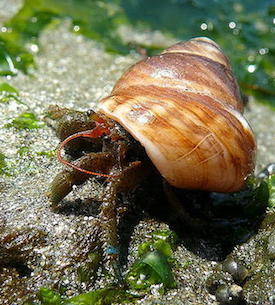Marine invertebrates also affected by ocean noise
Bioacoustics, Effects of Noise on Wildlife, Ocean, Science, Shipping Add commentsSome of the most interesting new work in ocean noise is revealing the myriad ways that humanity’s sounds can have negative impacts on ocean life other than marine mammals. Sure, everyone loves our warm-blooded kin, but there’s way more to the ocean ecosystem than dolphins, humpbacks, and seals. AEInews has been covering this leading edge for years (see these posts on shellfish larvae, crabs, and squid). Recently, at the triannual Effects of Noise on Aquatic Life conference, held this year in Dublin, a slew of new papers revealed further concerns.
 This post from NRDC summarizes the highlights. One of the most striking findings was that 6 hours of shipping noise can damage the DNA in the cells of mussels, perhaps due to a stress response; similarly, protein structures in the sensory cells of cuttlefish were damaged by low-frequency noise. These would be some of the most profound impacts yet discovered; note, though, that the brief summary here does not specify the sound levels—some research on health effects use much higher exposures than are likely in the wild, as a way of identifying possible effects for further study at lower exposure levels. Other new studies followed on previous ones that suggest many animals respond to noise as if it were a predator; these responses often suggest increased stress, and are waste of precious energy, or disrupt feeding. Also of note is a one-off anecdotal observation (not yet studied systematically) of a hermit crab exiting its shell after exposure to low-freqency sound; it appeared to be examining its shell, perhaps trying to determine the source of the disruption, or checking for physical damage. While out of its shell, it would be vulnerable to predation.
This post from NRDC summarizes the highlights. One of the most striking findings was that 6 hours of shipping noise can damage the DNA in the cells of mussels, perhaps due to a stress response; similarly, protein structures in the sensory cells of cuttlefish were damaged by low-frequency noise. These would be some of the most profound impacts yet discovered; note, though, that the brief summary here does not specify the sound levels—some research on health effects use much higher exposures than are likely in the wild, as a way of identifying possible effects for further study at lower exposure levels. Other new studies followed on previous ones that suggest many animals respond to noise as if it were a predator; these responses often suggest increased stress, and are waste of precious energy, or disrupt feeding. Also of note is a one-off anecdotal observation (not yet studied systematically) of a hermit crab exiting its shell after exposure to low-freqency sound; it appeared to be examining its shell, perhaps trying to determine the source of the disruption, or checking for physical damage. While out of its shell, it would be vulnerable to predation.
All this new research is both exciting, as it reveals the vast and subtle role of sound in the natural world, and sobering in facing us with the widespread consequences of our heedless sonic intrusions into wild ecosystems.
